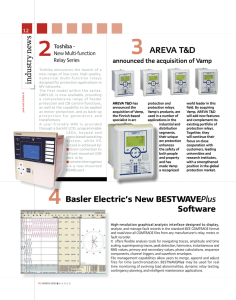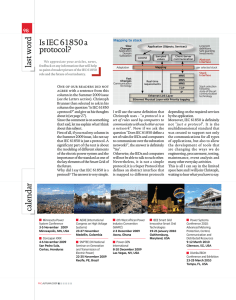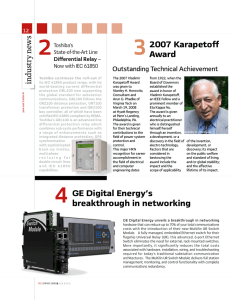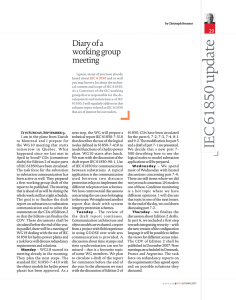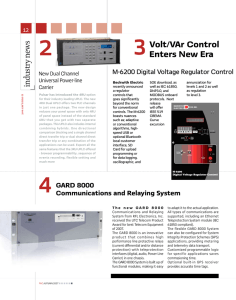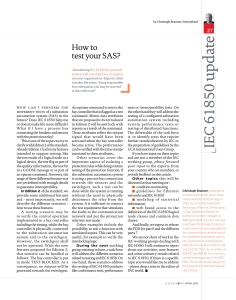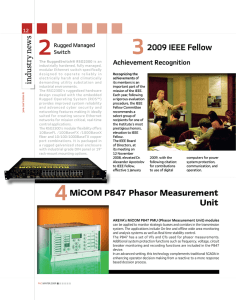g in st te
advertisement
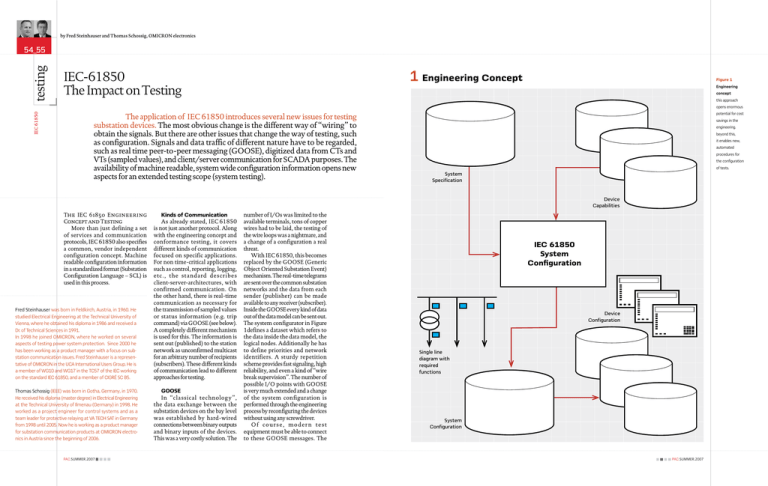
by Fred Steinhauser and Thomas Schossig, OMICRON electronics testing 54_55 1 Engineering Concept IEC-61850 The Impact on Testing Figure 1 Engineering concept this approach IEC 61850 opens enormous The application of IEC 61850 introduces several new issues for testing substation devices. The most obvious change is the different way of “wiring” to obtain the signals. But there are other issues that change the way of testing, such as configuration. Signals and data traffic of different nature have to be regarded, such as real time peer-to-peer messaging (GOOSE), digitized data from CTs and VTs (sampled values), and client/server communication for SCADA purposes. The availability of machine readable, system wide configuration information opens new aspects for an extended testing scope (system testing). potential for cost savings in the engineering. beyond this, it enables new, automated procedures for the configuration of tests. System Specification Device Capabilities The IEC 61850 Engineering Concept and Testing More than just defining a set of services and communication protocols, IEC 61850 also specifies a common, vendor independent con­figuration concept. Machine readable configuration information in a standardized format (Substation Configuration Language – SCL) is used in this process. Fred Steinhauser was born in Feldkirch, Austria, in 1960. He studied Electrical Engineering at the Technical University of Vienna, where he obtained his diploma in 1986 and received a Dr. of Technical Sciences in 1991. In 1998 he joined OMICRON, where he worked on several aspects of testing power system protection. Since 2000 he has been working as a product manager with a focus on substation communication issues. Fred Steinhauser is a representative of OMICRON in the UCA International Users Group. He is a member of WG10 and WG17 in the TC57 of the IEC working on the standard IEC 61850, and a member of CIGRÉ SC B5. Kinds of Communication As already stated, IEC 61850 is not just another protocol. Along with the engineering concept and conformance testing, it covers different kinds of communication focused on specific applications. For non time-critical applications such as control, reporting, logging, etc ., the st andard descr ibes client-server-architectures, with confirmed com­munication. On the other hand, there is real-time communication as necessary for the transmission of sampled values or status information (e.g. trip command) via GOOSE (see below). A completely different mechanism is used for this. The information is sent out (published) to the station network as unconfirmed multicast for an arbitrary number of recipients (subscribers). These different kinds of communication lead to different approaches for testing. Thomas Schossig (IEEE) was born in Gotha, Germany, in 1970. He received his diploma (master degree) in Electrical Engineering at the Technical University of Ilmenau (Germany) in 1998. He worked as a project engineer for control systems and as a team leader for protective relaying at VA TECH SAT in Germany from 1998 until 2005. Now he is working as a product manager for substation communication products at OMICRON electronics in Austria since the beginning of 2006. GOOSE In “classical technolog y”, the data exchange between the substation devices on the bay level was established by hard-wired connections between binary outputs and binary inputs of the devices. This was a very costly solution. The PAC.SUMMER.2007 number of I/Os was limited to the available terminals, tons of copper wires had to be laid, the testing of the wire loops was a night­mare, and a change of a configuration a real threat. With IEC 61850, this becomes replaced by the GOOSE (Generic Object Oriented Substation Event) mechanism. The real-time telegrams are sent over the common substation networks and the data from each sender (publisher) can be made available to any receiver (subscriber). Inside the GOOSE every kind of data out of the data model can be sent out. The system configurator in Figure 1defines a dataset which refers to the data inside the data model, the logical nodes. Additionally he has to define priorities and network identifiers. A sturdy repetition scheme provides fast signaling, high reliability, and even a kind of “wire break supervision”. The number of possible I/O points with GOOSE is very much extended and a change of the system configuration is performed through the engineering process by reconfiguring the devices without using any screwdriver. O f c o u r s e , mo de r n t e s t equipment must be able to connect to these GOOSE messages. The IEC 61850 System Configuration Device Configuration Single line diagram with required functions System Configuration PAC.SUMMER.2007 IEC 61850 testing 56 57 feedback from and stimulus to the devices under test that was formerly exchanged via binary I/Os, must now be established by “wiring” the test equipment to the substation network. The usage of standardized engineering data in SCL format substantially eases the setup of tests (Figure 2). New possibilities for system testing are described in the last paragraph. Sampled Values In a similar way as the (mostly binary) status information is transformed into data on the substation network, IEC 61850 specifies this as well for the instantaneous voltage and current values delivered by the VTs and CTs. These data are called “Sampled Values”. A so-called “merging unit” (MU) collects the signals from the sensors and merges the digitized values into a data stream published in the substation network. IEC 61850 does not describe any special sensor technology or focuses on conventional or non-conventional instrument transformers. The standard just describes the data transmission over the network. These sampled values are sent out as multicast messages (same as the GOOSE described above) with a defined priority and sampling rate. This way, measured values (e.g. the bus voltage for a busbar protection scheme) can be easily distributed to multiple bay devices. Known issues from classical wiring, like the burden of the wire loops, do no longer occur with this new technology. The usage of sampled values causes high traffic on the network. This issue must be considered during engineering of the communication network and for the configuration of the involved devices. Options for filtering (e.g. multicast addresses) and priority control should be foreseen and applied. Test equipment must be able to simulate merging units by publishing Sampled Values to be subscribed by the devices under test. Functional Testing of Protection By “wiring” protective relays and test sets through the substation communications network, the test configuration is just transformed Standardized and machine readable configuration information facilitates the IEC 61850 test setup into the networked world (Figure 3). Looking at classical testing of protection functions, the world appears not to have changed very much. Regarding the scope of test usually performed until now, this is true. The protection functions of the relays still work in the same way. E.g. testing a distance protection will be performed by using the exact same fault scenarios and assessment criteria as before. For an effective use of existing knowledge minimized training efforts to adopt to the new situation, it is important that a test system preserves the working environment f rom classical testing and allows the reuse of existing test procedures for 2 Usage of configuration information for testing IEC 61850 System Configuration System Configuration PAC.SUMMER.2007 use with IEC 61850. The standardized and machine readable configuration information significantly facilitates the test setup. Where wiring plans had to be investigated and test leads had to be manually connected to banana plugs in the past, many aspects of the test configuration can be efficiently supported by using the substation configuration data. Client/Server SCADA Communication The substation devices provide a lot of additional information to be used for SCADA purposes. These d at a had been never exchanged between peer devices on the bay level and were normally not available for testing. Using these data during testing was usually out of scope, since the access was provided through many different, vendor specific methods. Nevertheless, the testing of the communication to the SCADA system is an essential part of the commissioning of a substation which caused a lot of problems in the past. With IEC 61850, these data are all presented in a standardized way. The data model offers the data in the logical nodes to all services as they are defined in the standard. A tester may look up some status data (e.g. special pick-up information) by using a common tool for all relays. This will provide extended depth of testing. Also, the protection engineers will be able to assess many issues of the SCADA communication, which were formerly in the responsibility of the communication engineers. Conformance Testing Interoperability is one of the main goals of IEC 61850 [1], and flawless conformance to the protocols and services is a precondition for this. In part 10, the standard describes the conformance testing. I EC 61850 included this definition of “how to test conformance” from the beginning, which was a new approach and an important factor for the comparably smooth introduction of this new technology. Conformance testing is done in spec ially equipped laboratories as a part of the development process of the substation devices. When applying devices on site, conformance is already assumed not tested during commissioning. Thus, conformance testing is out of the scope of this article. System Testing System testing up to a certain extent was and is already applied. Prominent examples are the Endto-End tests for sophisticated line protection schemes. Now, with the availability of substation wide configuration data, the feasibility of tests involving more devices is very much facilitated. Test with multiple points of test signal injection and measurement of response will become more easily to implement in IEC 61850 inst allations . Beyond the capability to be simply connected to the subst ation net work , test sets used in such applications need to have the abilit y to perform coordinated and precisely synchronized tasks as a part of distributed, system wide test system. The ongoing progress of the technology prepares the ground for such system in the near future. 3 "Fully networked” protection testing GOOSE Protection Relay Test Set SV (Sampled Values) PAC.SUMMER.2007


